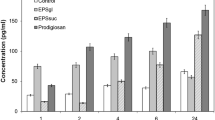Abstract
Certain aspects of the relationship between host defence mechanisms and the new quinoline derivative ciprofloxacin in comparison to norfloxacin and ofloxacin were studied. Ciprofloxacin did not affect chemotaxis of human polymophonuclear leucocytes in agarose. In leucocytes exposed to ciprofloxacin, norfloxacin and ofloxacin neither the chemiluminescent response to opsonized zymosan and formyl-methionyl-leucyl-phenylalanine nor the phagocytic or bactericidal activity was affected. However, killing ofStaphylococcus aureus by human polymorphonuclear leucocytes exposed to subinhibitory concentrations of ciprofloxacin was enhanced. The results show that the quinolines tested do not directly influence phagocytic cells, but a subinhibitory concentration can make bacteria more susceptible to phagocytosis and killing.
Similar content being viewed by others
References
Milatovic, D.: Antibiotics and phagocytosis. European Journal of Clinical Microbiology 1983, 2: 414–425.
Forsgren, A.: Comparative in vitro activity of three new quinolone antibiotics against recent clinical isolates. Scandinavian Journal of Infectious Diseases 1985, 17: 91–94.
Traub, W. H.: Intraphagocytic bactericidal activity of bacterial DNA gyrase inhibitors againstSerratia marcescens. Chemotherapy 1984, 30: 379–386.
Duncker, D., Ullmann, U.: Einfluß von Ciprofloxacin, Enoxacin und Norfloxacin auf die Phagozytose humaner neutrophiler Granulozyten, gemessen mit der Chemilumineszenz. Fortschritte der antimikrobiellen und antineoplastischen Chemotherapie 1984, 3–5: 633–635.
Bøyum, A.: Isolation of mononuclear cells and granulocytes from human blood. Scandinavian Journal of Clinical and Laboratory Investigation 1968, 21, Supplement 97: 77–89.
Nelson, R. D., Quie, P. G., Simmons, R. L.: Chemotaxis under agarose: a new and simple method for measuring chemotaxis and spontaneous migration of human polymorphonuclear leukocytes and monocytes. Journal of Immunology 1975, 115: 1650–1656.
Forsgren, A., Schmeling, D.: Effect of antibiotics on chemotaxis of human leucocytes. Antimicrobial Agents and Chemotherapy 1977, 11: 580–584.
Dahlgren, C., Stendahl, O.: Effect of in vitro preincubation of polymorphonuclear leucocytes on formylmethionylleucyl-phenyl-alanine induced chemiluminescence. Infection and Immunity 1982, 37: 34–39.
Allred, C. D., Hill, H. R.: Effect of chemoattractants on chemiluminescence. Infection and Immunity 1978, 19: 833–838.
Maaløe, O.: On the relation between alexin and opsonin. Einar Munksgaard, Copenhagen, 1946.
Hirsch, J. G., Strauss, B.: Studies on heat-labile opsonin in rabbit serum. Journal of Immunology 1964, 92: 145–154.
Forsgren, A., Schmeling, D.: Effect of antibiotics on chemotaxis of human leucocytes. Antimicrobial Agents and Chemotherapy 1977, 11: 580–584.
Ohnishi, H., Kosuzume, H., Inaba, H., Okura, M., Mochizuki, H., Suzuki, Y., Fujii, R.: Effects of AC-1370, a new semisynthetic cephalosporin on phagocyte functions. Antimicrobial Agents and Chemotherapy 1983, 23: 874–880.
Forsgren, A., Schmeling, D., Quie, P. G.: Effect of tetracycline on the phagocytic function of human leucocytes. Journal of Infectious Diseases 1974, 130: 412–415.
Alien, R. C., Losse, L. D.: Phagocytic activation of a luminol-dependent chemiluminescence in rabbit alveolar and peritoneal macrophages. Biochemical and Biophysical Research Communications 1976, 69: 245–252.
Hatch, G. E., Gardner, D. E., Menzel, D. B.: Chemiluminescence of phagocytic cells caused by N-formylmethionylpeptides. Journal of Experimental Medicine 1978, 147: 182–195.
Douglas, S. D., Quie, P. G. (ed.): Investigation of phagocytes in disease. Churchill Livingstone, Edinburgh, 1981, p. 53–60.
De Chatelet, L. R., Long, G. D., Shirley, P. S., Bass, D. A., Thomas, M. J., Henderson, F. W., Cohen, M. S.: Mechanism of the luminol-dependent chemiluminescence of human neutrophils. Journal of Immunology 1982, 129: 1589–1593.
McDonald, P. J., Wetherall, B. L., Pruul, H.: Post-antibiotic leucocyte enhancement. Increased susceptibility of bacteria pretreated with antibiotics to activity of leucocytes. Reviews of Infectious Diseases 1981, 3: 38–44.
Horne, D., Tomasz, A.: Hypersusceptibility of penicillin-treated group B streptococci to bactericidal activity of human polymorphonuclear leucocytes. Antimicrobial Agents and Chemotherapy 1981, 19: 745–753.
Alexander, J. W., Good, R. A.: Effect of antibiotics on the bactericidal activity of human leucocytes. Journal of Laboratory and Clinical Medicine 1968, 71: 971–983.
Milatovic, D.: Effect of subinhibitory antibiotic concentrations on the phagocytosis ofStaphylococcus aureus. European Journal of Clinical Microbiology 1982, 1: 97–101.
Elliot, G. R., Peterson, P. K., Verbrugh, H. A., Freiberg, M. R., Hoidal, J. R., Quie, P. C.: Influence of subinhibitory concentrations of penicillin, cephalothin, and clindamycin onStaphylococcus aureus growth in human phagocytic cells. Antimicrobial Agents and Chemotherapy 1982, 22: 781–784.
Michel, J., Ferner, M., Borinski, R., Kornberg, Z., Bergner-Rabinowitz, S., Ginsbutg, I.: Effects of subminimal inhibitory concentrations of chloramphenicol, erythromycin and penicillin on group A streptococci. European Journal of Clinical Microbiology 1982, 1: 375–380.
Gemmel, C. G., Peterson, P. K., Schmeling, D., Mathews, J., Quie, P. G.: Antibiotic-induced modification ofBacterioides fragilis and its susceptibility to phagocytosis by human polymorphonuclear leucocytes. European Journal of Clinical Microbiology 1983, 2: 327–334.
Milatovic, D., Braveny, I., Verhoef, J.: Clindamycin enhances opsonization ofStaphylococcus aureus. Antimicrobial Agents and Chemotherapy 1983, 24: 413–417.
Andreana, A., Perna, P., Utili, R., Dilillo, M., Ruggiero, G.: Increased phagocytosis and killing ofEscherichia coli treated with subinhibitory concentrations of cefamandole and gentamicin in isolated rat livers. Antimicrobial Agents and Chemotherapy 1984, 25: 182–186.
Bassaris, H. P., Lianou, P. E., Votta, E. G., Skoutelis, A. T., Papavassiliou, J. T.: Enhancement of polymorphonuclear leucocyte function against gram-positive aerobic organisms grown in the presence of lincomycin. Infection 1984, 12: 369–371.
Author information
Authors and Affiliations
Rights and permissions
About this article
Cite this article
Forsgren, A., Bergkvist, P.I. Effect of ciprofloxacin on phagocytosis. Eur. J, Clin. Microbiol. 4, 575–578 (1985). https://doi.org/10.1007/BF02013398
Issue Date:
DOI: https://doi.org/10.1007/BF02013398




